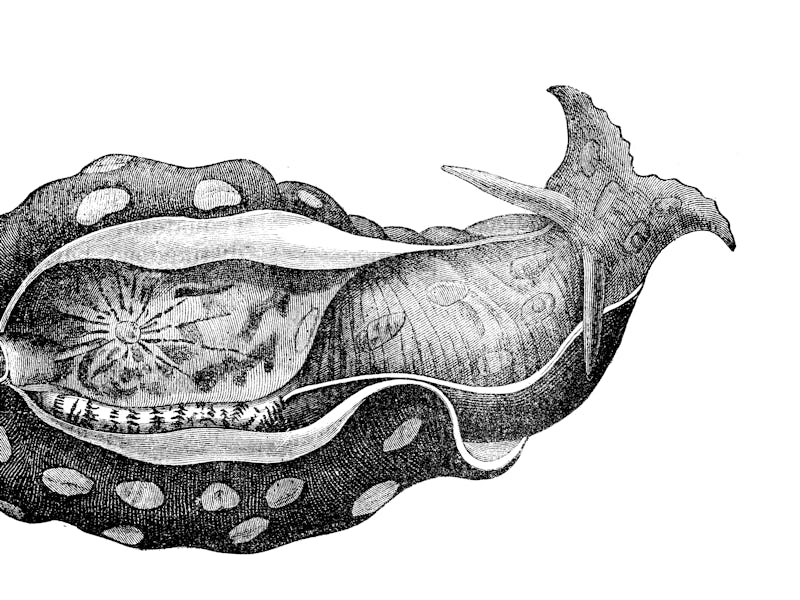Sea slug study explains what happens when a human brain learns
New research explains what allows learning to influence behavior.

Human memory is a notoriously multitiered phenomenon. When you recall a moment, you might think of a constellation of details — sounds, sights, and feelings.
This implies that experiences are stored in a variety of locations in the brain, studies suggest. But pinning down exactly what type of experiences live where has puzzled scientists for decades.
Now, researchers are one step closer to unraveling this mystery. In a recent study, scientists analyzed the brains of a seemingly unhuman-like animal, sea slugs, and discovered a crucial link between memories, brain regions, and the act of learning.
These findings were published Monday in the Journal of Neuroscience.
In a strange sea slug experiment, scientists determined that learning influences behavior by inducing multiple, simultaneous changes to synapses — the connections between brain cells. This discovery may explain why human learning involves a wide range of brain regions, at the same time.
“Learning can change synapses at multiple locations, and not only change the strength of the connections but even the sign of connections,” coauthor Hillel Chiel, a biologist at Case Western University, tells Inverse.
“Understanding the mechanisms of how this works is likely to open new directions for understanding the formation of memory in more complex animals and in humans.”
One of the sea slugs analyzed in the new study.
Chiel and his colleagues analyzed how synapses in the Aplysia — a sea slug found across the Atlantic, Mediterranean, and Indio-Pacific oceans — change after the animals learn a new behavior. These animals typically grow to be a foot long and have large nerve cells that can be individually identified.
"In sea slugs, connections between nerve cells can be mapped, and the circuits that these connections form can be related to behavior," coauthor Abraham Susswein, a neurobiologist at Bar Ilan University, tells Inverse.
"It is much more difficult, or impossible, to do this type of detailed mapping in animals that are more similar to humans."
In the experiment, slugs tried and failed to consume seaweed wrapped in plastic. In turn, when they failed to bite the seaweed through the plastic, they made progressively fewer attempts to swallow food. Eventually, they stopped trying completely.
Over time, as this scenario is repeated, the slugs encode long term memory that biting or attempting to swallow the seaweed simply won't work. They learn to reject the food outright.
A visualizaton of the sea slugs before and after the experiment.
Over the course of the experiment, the team analyzed hundreds of synaptic connections in the slug brains.
This analysis revealed that, after learning to reject food, synapses in the network of neurons responsible for "touch-sensing" underwent a variety of changes. Some synapses strengthened, others weakened, and some became excitatory — increasing the likelihood a neuron will fire— or inhibitory, having the opposite effect.
Experience with the plastic-wrapped seaweed functionally rewired the slugs' brain connections over time, and spurred massive changes in feeding behavior.
While humans and sea slugs might not seem like the most obvious animals to compare, the scientists say this process may also play out similarly in human brains. The team reasons that learning likely influences behavior in human brains as well, because the process changes synapses.
“A wonderful aspect of biology is that if you solve a hard problem in an animal that is easier to study experimentally, you can then solve the problem in more complex animals and in humans," Chiel says.
What the team wants to understand, Chiel says, "is how point to point connections between nerve cells change, and how this affects overall behavior." In the far-off future, this understanding could to much more than a better understanding of memory, he says — it is critical for the development of "truly flexible and adaptive" brain-computer interfaces.
Abstract: Learning causes local changes in synaptic connectivity and coordinated, global changes affecting many aspects of behavior. How do local synaptic changes produce global behavioral changes? In the hermaphroditic mollusc Aplysia, after learning that food is inedible, memory is expressed as bias to reject a food, and to reduce responses to that food. We now show that memory is also expressed as an increased bias to reject even a non-food object. The increased bias to rejection is partially explained by changes in synaptic connections from primary mechano-afferents to five follower neurons with well-defined roles in producing different feeding behaviors. Previously, these mechanoafferents had been shown to play a role in memory consolidation. Connectivity changes differed for each follower neuron the probability that cells were connected changed; excitation changed to inhibition and vice versa; and connection amplitude changed. Thus, multiple neural changes at different sites underlie specific aspects of a coordinated behavioral change. Changes in the connectivity between mechanoafferents and their followers cannot account for all of the behavioral changes expressed after learning, indicating that additional synaptic sites are also changed. Access to the circuit controlling feeding can help determine the logic and cellular mechanisms by which multiple local synaptic changes produce an integrated, global change in behavior.